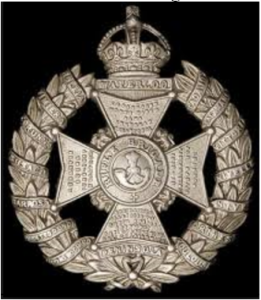Wednesday, February 24, 1915
In billets, Armentières
The Battalion War Diarist wrote for this day: “At night two platoons each of Nos. 1 and 2 companies and Battn. H.Q. went into trenches opposite Pérenchies for instruction with 1st Battalion North Staffords, Lt.-Col. De Falbe; two platoons each of Nos. 3 and 4 with Rifle Brigade at Chapelle D’Armentières.” [1]
THIS DAY IN RMR HISTORY: “… February 24th, exactly six months after the battalion had left Montreal, arrangements were made for several platoons to undergo a short period of instruction in the front line. One diarist mentions “a great rivalry and wire pulling to be allowed to go with the first lot into the trenches,” officers and men being keen for the honour of accompanying those detachments of the Regiment to come first under fire.”

“The North Staffordshire Regiment (Prince of Wales’s) was an infantry regiment of the British Army, which was in existence between 1881 and 1959. The 64th Regiment of Foot was created on 21 April 1758 from the 2nd Battalion of the 11th Regiment.[2] In 1881, the 64th Foot was merged with the 98th (Prince of Wales’s) Regiment of Foot (originally raised in 1824) to form the new regiment.
Formed at a time when the British Empire was reaching its peak, the Regiment served all over the Empire, in times of both peace and war, and in many theatres of war outside the Empire. It fought in World War I and World War II, as well as in other smaller conflicts around the world. These other wars included the Second Sudanese War, the Second Boer War, the Anglo-Irish War and the Third Anglo-Afghan War. In 1959, as part of a defense review, the regiment was amalgamated with the South Staffordshire Regiment to form the Staffordshire Regiment (Prince of Wales’s). Today the traditions of the Regiment are continued by the 3rd Battalion, the Mercian Regiment.” [i]

“The Rifle Brigade (Prince Consort’s Own) was an infantry rifle regiment of the British Army. Formed in January 1800 as the “Experimental Corps of Riflemen” to provide sharpshooters, scouts and skirmishers, they were soon renamed “The Rifle Corps”. In January 1803 they became an established regular regiment and were titled the 95th Regiment of Foot (Rifles). In 1816, after the final defeat of Napoleon, they were again renamed, this time as “The Rifle Brigade”.
The Corps differed in several regards from the Line infantry of the British Army. Most significantly, the Rifles were armed with the formidable Baker rifle, which was more accurate and of longer range than the musket, although it took longer to load. As the rifle was shorter than the musket, it was issued with a 21-inch sword bayonet.
Riflemen wore dark green jackets rather than the bright red coats of the British line infantry regiments of that time; close-fitting pantaloons, rather than breeches; black facings and black belts rather than white; a green plume on their “stovepipe shakoes” which the light infantry also wore, as well as other accoutrements unique to Rifles regiments.
The Rifle Brigade fielded 28 battalions during the First World War, from its original complement of 4 regular and 2 reserve, seeing service primarily on the Western Front, but also in Macedonia. The regiment lost 11,575 killed during the course of the war. They were awarded 52 battle honours, 10 Victoria Crosses and numerous other decorations.” [3]
[1] War Diary, 14th Canadian Battalion, The Royal Montreal Regiment, Feb 24, 1915. Library and Archives Canada, Ottawa, http://data2.collectionscanada.ca/e/e044/e001089695.jpg
[2] Wikipedia contributors, "North Staffordshire Regiment," Wikipedia, The Free Encyclopedia, http://en.wikipedia.org/w/index.php?title=North_Staffordshire_Regiment&oldid=637383878 (accessed December 19, 2014).
[3] Wikipedia contributors, "Rifle Brigade (Prince Consort's Own)," Wikipedia, The Free Encyclopedia, http://en.wikipedia.org/w/index.php?title=Rifle_Brigade_(Prince_Consort%27s_Own)&oldid=636026252 (accessed December 19, 2014).

